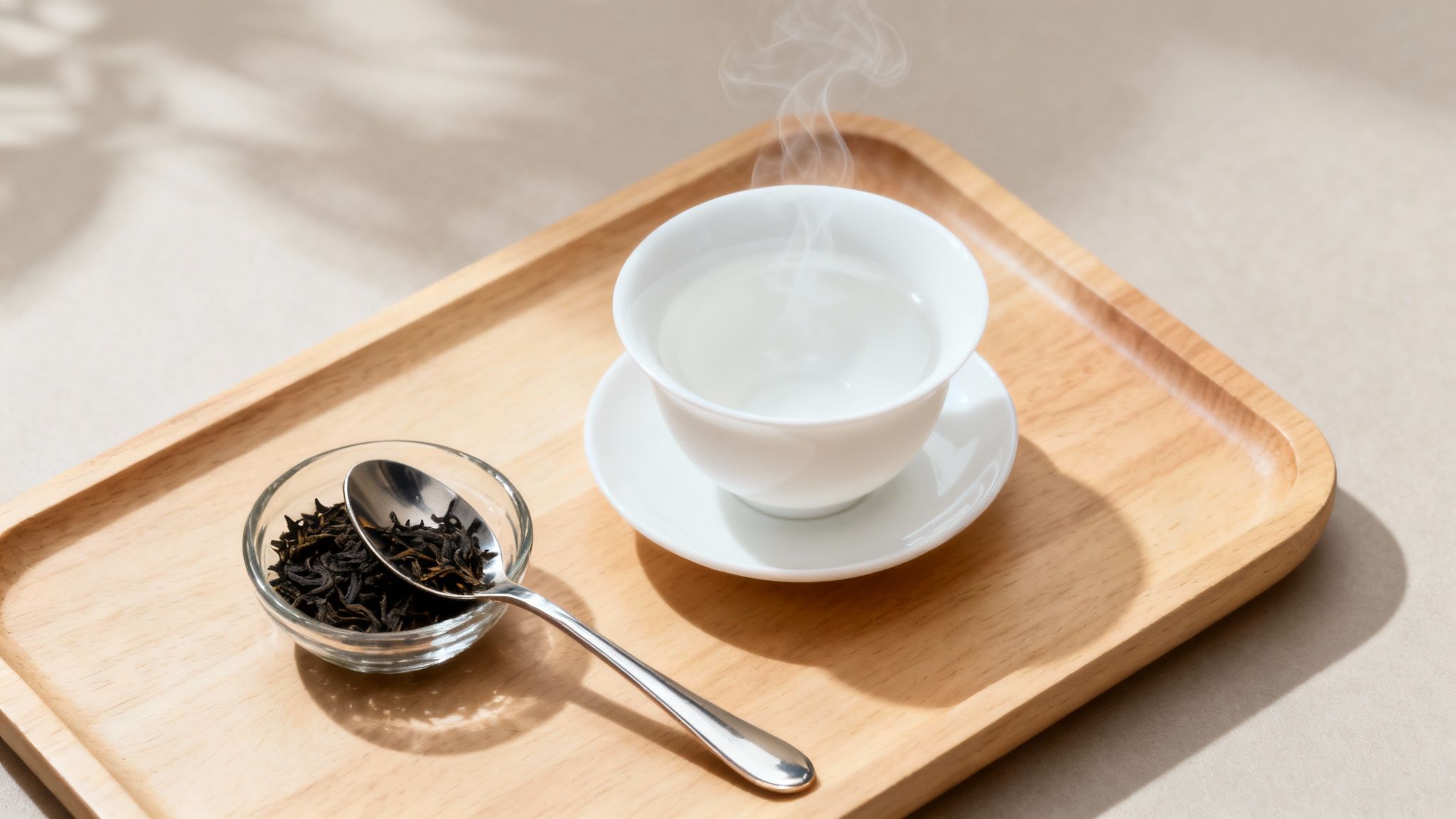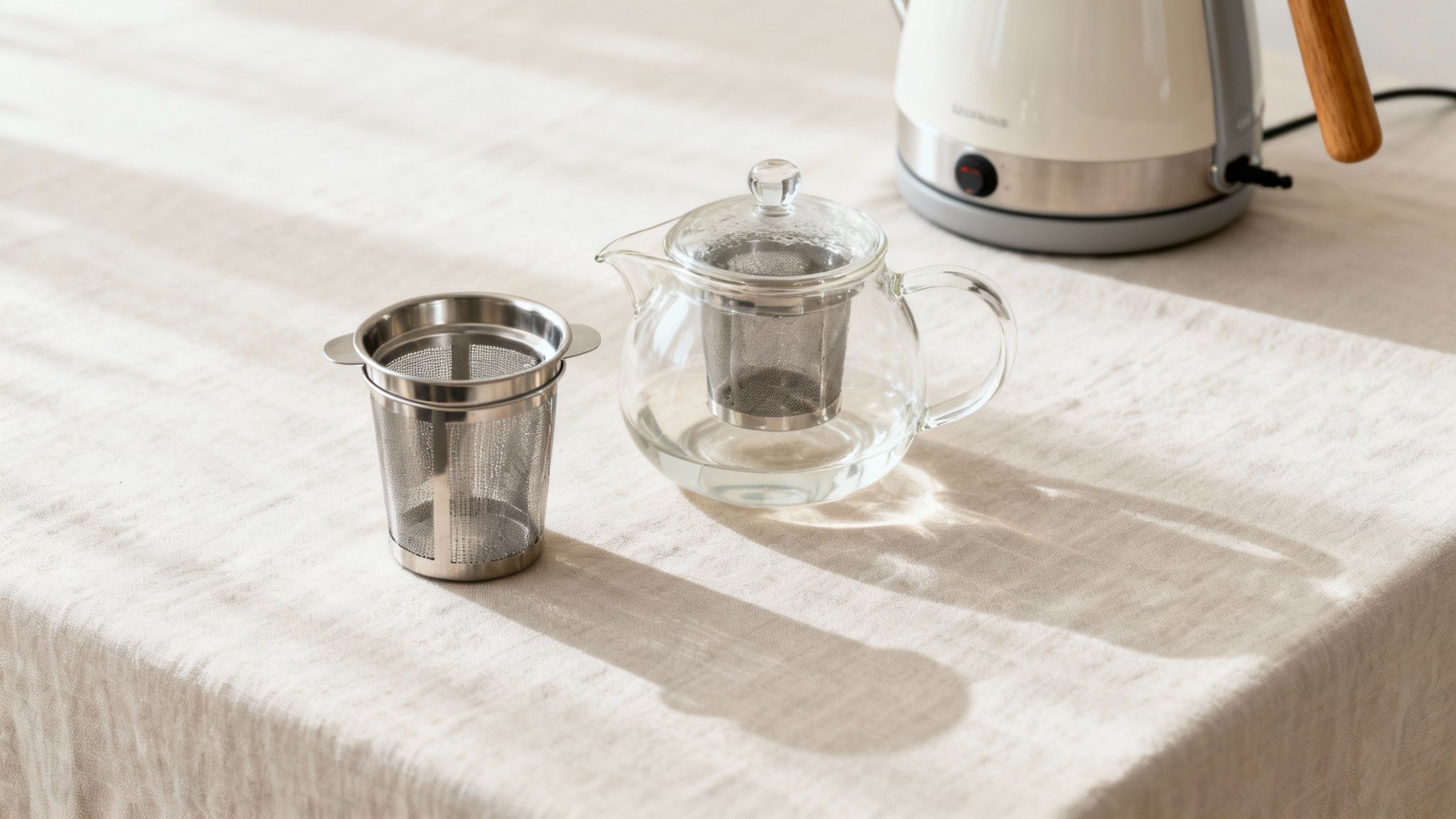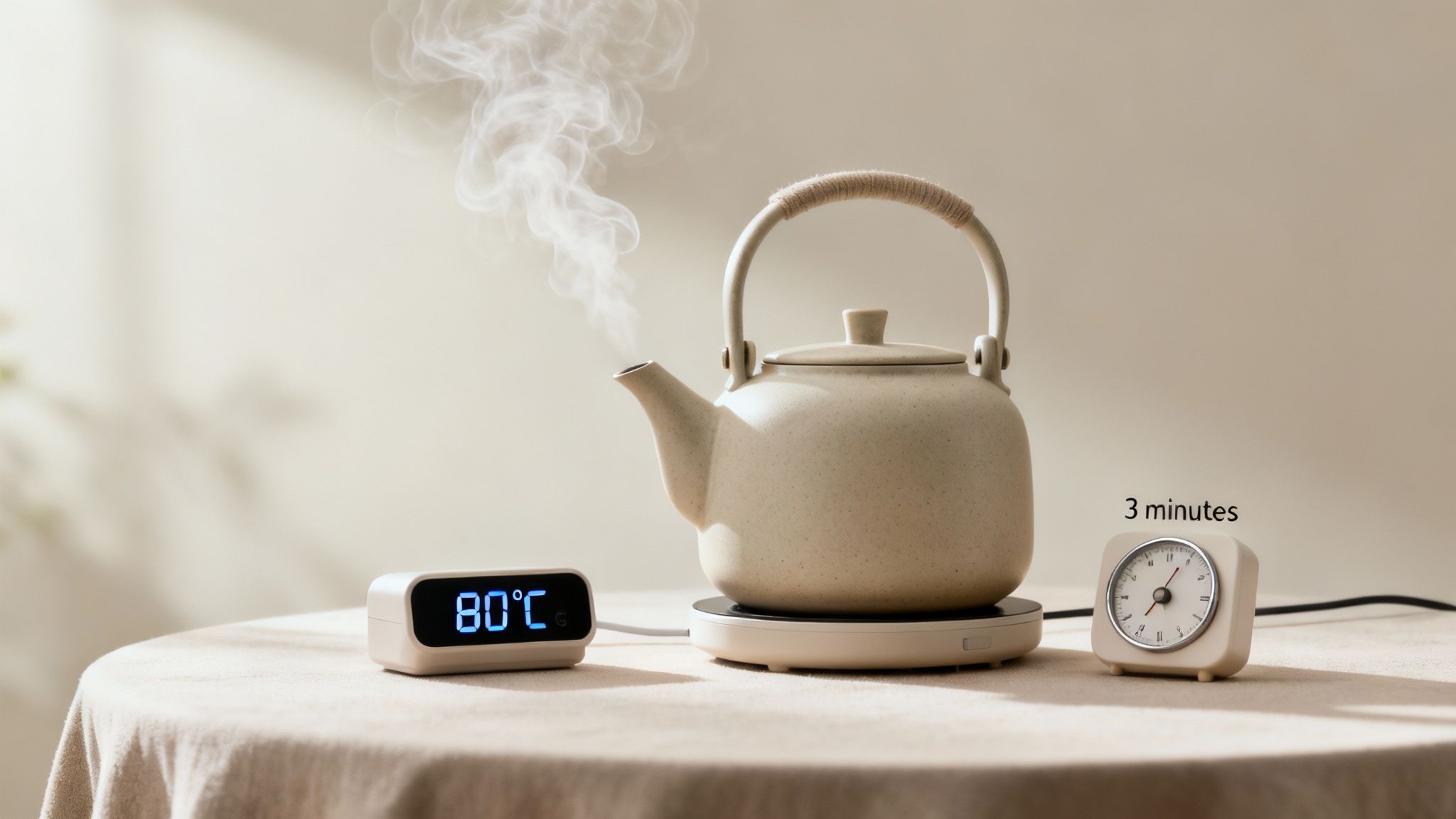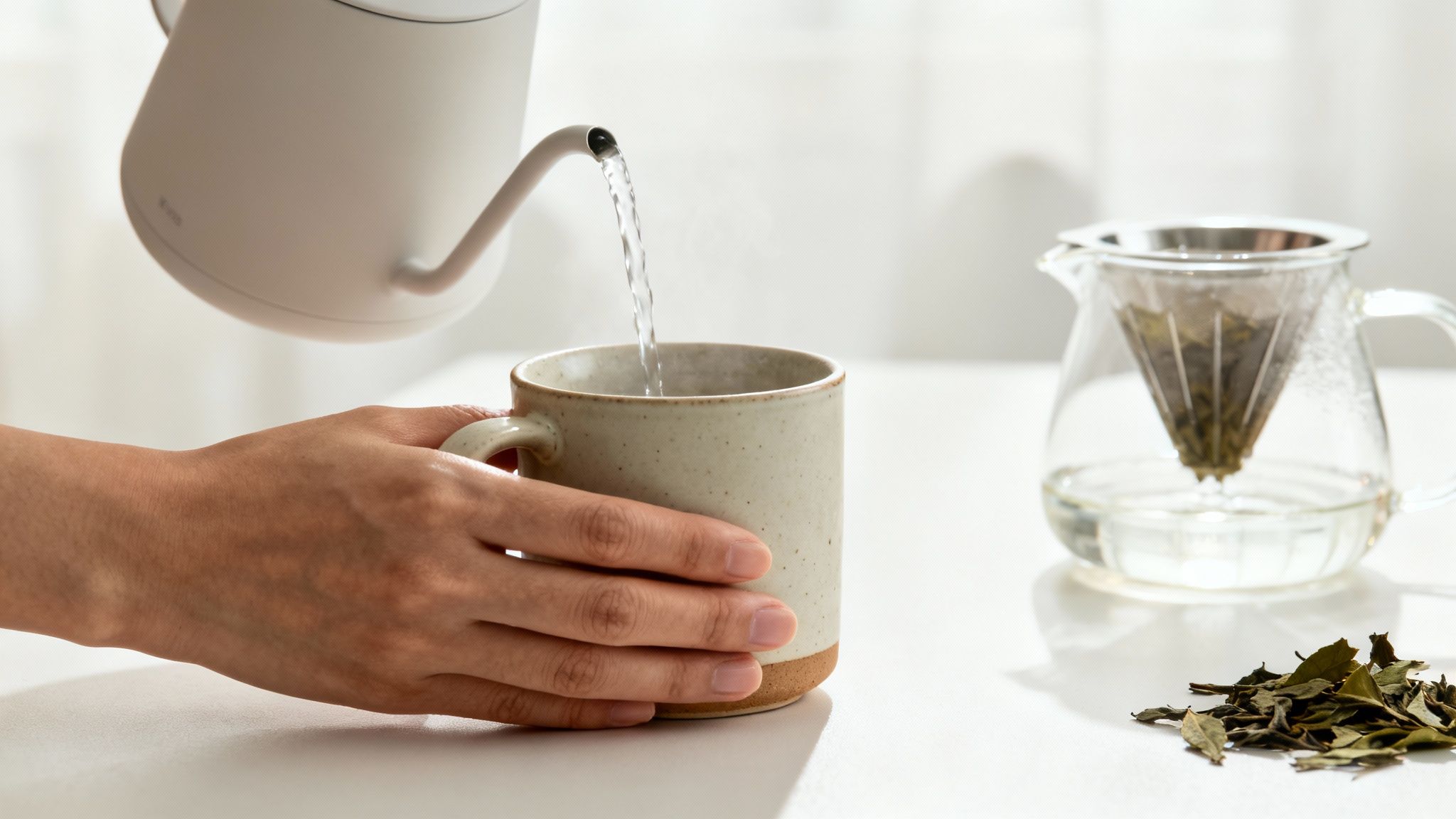Making loose leaf tea is beautifully simple. It all boils down to three things: measuring your tea leaves, heating your water to just the right temperature, and steeping for the perfect amount of time. Get these right, and you’ll unlock a depth of flavour you just can't find in a standard tea bag.
Your Journey into the Art of Brewing Loose Leaf Tea

If you've only ever dunked a tea bag in a mug, you're in for a treat. Moving to loose leaf tea is like switching from instant coffee to freshly ground beans—the difference in aroma and flavour is night and day.
Unlike the fine 'dust' you often get in bags, whole leaves have the space they need to unfurl and release their full, nuanced character. This guide will demystify the process, turning what might seem like a complex art into an easy, enjoyable daily ritual.
Why Choose Loose Leaf Tea?
The benefits go far beyond just taste. When you learn how to make loose leaf tea, you gain complete control over your brew. You can dial in the strength, play around with steeping times, and even re-steep high-quality leaves for multiple infusions.
This small change elevates your daily cup from a quick habit to a mindful moment.
It’s interesting, though. Despite Britain's deep-rooted tea culture, most of us haven't made the switch. Recent data from the UK Tea and Infusions Association showed that a staggering 84% of Brits still prefer the convenience of tea bags, with only 16% opting for loose leaf. You can learn more about these fascinating UK tea trends, and see why you're joining a community dedicated to a superior brewing experience.
The secret to a perfect cup lies in three simple variables: the amount of tea, the water's temperature, and how long you let it steep. Mastering these is the key to unlocking exceptional flavour at home.
To get you started, I've put together a quick reference table for some of the most popular tea types. Think of it as your cheat sheet.
Quick Guide to Brewing Loose Leaf Tea
This little chart is a great starting point for the most common teas. Don't be afraid to experiment, but this will set you on the right path.
| Tea Type | Tea per 250ml | Water Temperature | Steep Time |
|---|---|---|---|
| Black Tea | 1 tsp (2-3g) | 95-100°C | 3-5 mins |
| Green Tea | 1 tsp (2-3g) | 75-80°C | 1-3 mins |
| Herbal Infusion | 1-2 tsp (3-4g) | 100°C | 5-7 mins |
Remember, these are guidelines, not strict rules. Your palate is the ultimate judge, so feel free to adjust these to suit your own taste. Happy brewing
Choosing Your Essential Tea Brewing Tools

You really don't need a kitchen overflowing with gadgets to brew a truly exceptional cup of loose leaf tea. It all comes down to a few key pieces that give your tea leaves what they crave most: room to unfurl and perfectly heated water.
Your most crucial tool? A good infuser. I’m not talking about those tiny, novelty tea balls that squeeze the life out of the leaves. You need something that gives them space, allowing the water to circulate freely. That’s the secret to coaxing out all those complex, wonderful flavours.
Finding the Right Infuser
The best infusers give your tea leaves plenty of room to dance around and expand as they soak up the water. Your choice will probably depend on sheer convenience and whether you’re brewing for one or a few.
- Basket Infusers: These are my go-to for daily brewing. They pop right into your mug, are a doddle to fill, and even easier to clean.
- Teapots with Built-in Strainers: Absolutely perfect for when you've got company. They keep the whole process neat, tidy, and effortlessly elegant.
- Infuser Tea Mugs: An all-in-one solution that’s incredibly handy for a quick, quality brew at your desk. We’ve actually put together a guide on our favourite infuser tea cups if you want to take a closer look.
And when it comes to the vessel itself, something like a durable titanium mug can be a fantastic, lightweight partner for a basket infuser, adding a modern touch to your ritual.
Honestly, the single biggest upgrade you can make is switching to an infuser that lets the leaves properly expand. It's a simple change that unlocks a depth of flavour that cramped tea balls just can't compete with.
The Kettle and Other Bits
After the infuser, a quality kettle is your next best friend. If you really want to elevate your brewing, a variable-temperature kettle is a game-changer. It takes all the guesswork out of hitting that perfect 80°C for a delicate green tea, preventing the bitterness that comes from scorching the leaves with boiling water.
It's interesting to see how this more thoughtful approach is catching on. Recent data shows that 27% of people aged 30–44 now prefer loose leaf tea, compared to just 10% of those over 60. It seems the appreciation for quality brewing is growing. With the right kit, you’re all set for a consistently delicious cup, every single time.
Mastering Water Temperature and Steeping Time

Alright, you’ve got your gear sorted. Now we get to the heart of a truly great brew: water temperature and steeping time. Think of these two as a partnership; they work together to coax out the best flavours from your leaves. Get them right, and you're in for a treat. Get them wrong, and you'll quickly understand why some people think they don't like tea.
One of the most common mistakes I see is using water that's far too hot, especially for delicate leaves. It literally scalds them, releasing bitter tannins and creating an astringent, unpleasant taste. On the flip side, water that’s too cool will leave you with a weak, flavourless cup because it can’t extract all those wonderful oils and compounds.
Every tea has its sweet spot.
Finding The Right Temperature
The various https://www.jeevesandjericho.com/blogs/news/types-of-tea we enjoy aren't all the same, so why would we treat them that way? A robust Assam or a dark herbal blend can handle a proper rolling boil, but that same heat would utterly ruin a delicate Japanese Sencha.
It's actually a growing trend, especially among younger tea drinkers, to pay more attention to these details. In fact, 28% of people aged 18-29 now prefer loose leaf for their green and herbal teas, which really shows an appreciation for getting the brewing just right.
To make things simple, here’s a quick guide to some of the main tea types.
Tea Brewing Temperatures and Times
Getting the temperature and timing spot on is what separates a good cup of tea from a truly memorable one. Below is a handy chart to guide you, but remember to treat it as a starting point. Your own palate is the most important tool you have!
| Tea Type | Ideal Water Temperature (°C) | Recommended Steep Time | Flavour Profile Notes |
|---|---|---|---|
| White Tea | 75-80°C | 1-3 minutes | Delicate, sweet, and floral. Highly sensitive to heat. |
| Green Tea | 80-85°C | 1-2 minutes | Grassy, vegetal, or nutty. Over-steeping quickly leads to bitterness. |
| Oolong Tea | 85-95°C | 2-4 minutes | Incredibly diverse, from floral and light to dark and roasted. |
| Black Tea | 95-100°C | 3-5 minutes | Bold, malty, and robust. Needs hot water to fully extract its deep flavour. |
| Herbal Tea | 100°C | 5-7 minutes | Varies widely, but most botanicals can handle boiling water to release their essence. |
Think of these numbers as your baseline. From here, you can start experimenting to discover exactly what you enjoy.
Steeping time is the other half of the equation. It's a delicate balance—you want to extract all the delicious flavours and aromas without drawing out too much bitterness. Shorter times mean a lighter cup; longer steeps give you a stronger, more intense brew.
Your personal taste is the final judge. Use these times as a starting point, then adjust by 30 seconds in either direction until you find the balance you love.
And if you’re making a larger pot for friends, remember that the principles stay the same, you just need to know how to scale your tea brewing recipe to keep the flavour consistent.
Creating Your Own Tea Ritual

Right, let's put it all into practice. Forget rigid rules for a moment. Learning how to make loose leaf tea is really about creating a small, personal ritual—a quiet moment that can turn a simple brew into a mindful pause in your day.
Here's a tiny detail that makes a world of difference: always pre-warm your teapot and mug. Just a quick swirl of hot water is all it takes. Pour it out, and you've stopped the cold ceramic from dropping the temperature of your brew. It's a simple touch, but your tea will stay at the perfect temperature for so much longer.
The Art of the Pour
Pop your tea leaves into your infuser. A good starting point is one teaspoon for a 250ml cup, but honestly, you should play around and see what you prefer. Once the kettle’s boiled and cooled to the right temperature, pour the water over the leaves.
I find it's best to use a steady, gentle flow. It helps the leaves unfurl and awaken gracefully rather than just getting blasted. As the pot fills, watch the leaves start to dance and release their colour and aroma. This is where the magic happens.
The goal isn’t just to make tea; it’s to enjoy the process. From the sound of the water to the aroma of the steeping leaves, each step is part of the experience. It’s a simple pleasure that grounds you in the present moment.
It seems more and more people are catching on to this. Globally, the loose leaf market is expected to reach an incredible $1.68 billion USD by 2033. While we in the UK are still big fans of our classic black teabags, there's a definite shift towards appreciating quality. You can dive deeper into the stats with this insightful UK tea census study.
Unlocking More Flavour with Re-Steeping
One of the best things about good quality loose leaf tea is that you can often use the leaves more than once. Oolongs and certain green teas, in particular, are fantastic for multiple infusions, with each steep revealing new layers of flavour.
- First Steep: This is usually the boldest, most direct expression of the tea's character.
- Second & Third Steeps: You'll often discover more subtle, complex notes that were hiding in the background.
To give it a go, just make sure you drain every last drop of water from the leaves after your first brew, then simply add freshly heated water. You'll probably want to add an extra 30-60 seconds to your steep time for each new infusion. It's a brilliant, wallet-friendly way to get the most out of every single leaf.
Common Tea Brewing Mistakes to Avoid
Even the most seasoned tea drinkers can fall into simple traps that ruin a perfectly good cup. Getting the hang of loose leaf tea is often just about learning what not to do. A few small tweaks to your routine can help you sidestep common issues and guarantee a delicious brew every single time.
One of the most frequent slip-ups is simply using the wrong amount of tea. It's an easy mistake to make, but it results in a cup that’s either disappointingly weak or unpleasantly strong. The classic 'one teaspoon per cup' rule is a great starting point, but feel free to adjust from there until you find your sweet spot.
Your water also makes a world of difference. If your tap water tastes of chlorine or is particularly hard, it will absolutely smother the delicate flavours in your tea leaves. Switching to filtered water is probably the single easiest upgrade you can make to your daily ritual.
Over-Steeping and Poor Storage
The number one culprit behind a bad cup of tea? Over-steeping. This is especially true for delicate green teas, where even an extra 30 seconds can unleash a wave of bitterness. Always, always use a timer—it’s your best friend in the fight against a bitter brew.
Protecting your tea from its enemies—air, light, heat, and moisture—is just as important as your brewing technique. Proper storage preserves the delicate flavour and aroma that make loose leaf tea so special.
Finally, don't forget about storage. Tea is incredibly absorbent and will happily soak up the aromas of anything nearby, from your morning coffee beans to that pungent curry powder in the cupboard. Keep your leaves fresh and full of character by storing them in an airtight, opaque container tucked away in a cool, dark place.
With the average Brit drinking around 500 cups of tea a year, it’s amazing how many of these simple mistakes persist, usually thanks to habits picked up from using tea bags. If you dive into the nation's tea drinking routines, you'll quickly see why putting that little bit of extra care into your loose leaf makes all the difference.
Got Questions? We've Got Answers
Once you start exploring the world of loose leaf tea, you’re bound to have a few questions. It’s all part of the fun. We hear these ones a lot, so let's clear things up and get you brewing with confidence.
Can I Steep The Same Leaves More Than Once?
You absolutely can, and you absolutely should! This is one of the joys of using proper whole leaf tea. Re-steeping is where the real magic happens.
Many teas, particularly oolongs and high-quality greens, are crafted to be infused multiple times. Each time you add hot water, you’ll unlock subtle new layers of flavour and aroma. It's like a conversation with the tea, with each steep revealing a different part of its story. Just be sure to drain the leaves completely between infusions.
How Much Tea Should I Use For One Mug?
A good rule of thumb to start with is one teaspoon (about 2-3 grams) of tea for every 250ml of water, which is roughly your standard mug size.
But think of this more as a friendly suggestion than a strict rule. Some teas are light and fluffy, like a Silver Needle white tea, so you might need a more generous spoonful. Others, like a tightly-rolled oolong, are much denser and require less. Start with our baseline and see what you think. You can always adjust from there.
The best part about brewing loose leaf tea is making it your way. Play around with the amount of leaf and how long you let it steep. The perfect cup is the one that tastes perfect to you.
What’s The Best Way To Keep My Tea Fresh?
To protect those gorgeous, nuanced flavours, you need to shield your tea from its four enemies: light, heat, moisture, and strong smells.
An airtight tin or caddy stored in a cool, dark cupboard is your best bet. And make sure to keep it away from your coffee beans or spice rack—tea leaves are incredibly absorbent and will happily soak up any nearby aromas, which you probably don't want in your Darjeeling.
Beyond the incredible taste, there are so many other reasons to make the switch. If you're curious, you can dive into all the loose leaf tea benefits in our guide.
Ready to find a brew you'll love? Take a look through our curated collection at Jeeves & Jericho and discover your new favourite whole leaf tea.
https://www.jeevesandjericho.com


